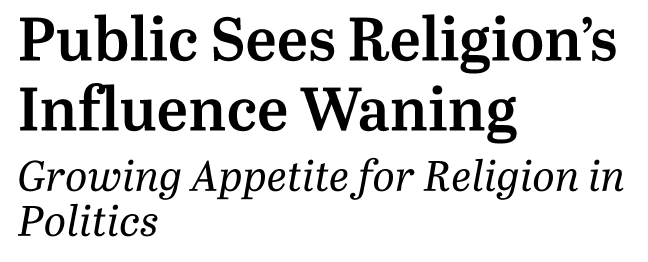Possibly the most depressingly subtitled report I’ve ever yet seen from the Pew Research Center came out yesterday:

I really like that first part, but find myself literally shuddering at that last bit. Here is the brief overview at Pew, here is the full report.
The analysts at Pew failed to highlight the volatility in their leading metric, that is, the perception of whether religion is losing influence or gaining influence in American life. This shows up as the first graph in both the overview and the full report. Here is what that graph would look like if we included all the available data:

Notice that the perception of increasing influence of religion spikes up in times of crisis, such as the height of Cold War nuclear terror and when the Islamist terrorists struck in 2001. Nevertheless, it is encouraging to see the red line going in generally the right direction. That’s the good news, now for the bad news . . .

Well, now this is just cringeworthy. Anyone care to speculate on why this is happening? I don’t think the report quite gets to the root of the problem:
The findings reflect a widening divide between religiously affiliated Americans and the rising share of the population that is not affiliated with any religion (sometimes called the “nones”). The public’s appetite for religious influence in politics is increasing in part because those who continue to identify with a religion (e.g., Protestants, Catholics and others) have become significantly more supportive of churches and other houses of worship speaking out about political issues and political leaders talking more often about religion. The “nones” are much more likely to oppose the intermingling of religion and politics.
It’s obvious why the nones would tend to oppose the intermingling of religion and politics, but it’s much less obvious why the rise of the nones has coincided with a regression away from separationism on the part of religiously affiliated Americans.
